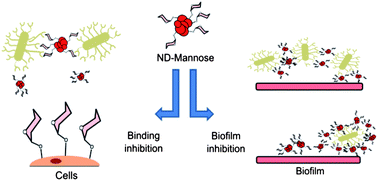Bacterial attachment and subsequent biofilm formation on biotic surfaces or medical devices is an increasing source of infections in clinical settings. A large proportion of these biofilm-related infections are caused by Escherichia coli, a major nosocomial pathogen, in which the major adhesion factor is the FimH adhesin located at the tip of type 1 fimbriae. Inhibition of FimH-mediated adhesion has been identified as an efficient antibiotic-alternative strategy to potentially reduce E. coli-related infections. In this article we demonstrate that nanodiamond particles, covently modified with mannose moieties by a “click” chemistry approach, are able to efficiently inhibit E. coli type 1 fimbriae-mediated adhesion to eukaryotic cells with relative inhibitory potency (RIP) of as high as 9259 (bladder cell adhesion assay), which is unprecedented when compared with RIP values previously reported for alternate multivalent mannose-functionalized nanostructures designed to inhibit E. coli adhesion. Also remarkable is that these novel mannose-modified NDs reduce E. coli biofilm formation, a property previously not observed for multivalent glyco-nanoparticles and rarely demonstrated for other multivalent or monovalent mannose glycans. This work sets the stage for the further evaluation of these novel NDs as an anti-adhesive therapeutic strategy against E. coli-derived infections.

You have access to this article
 Please wait while we load your content...
Something went wrong. Try again?
Please wait while we load your content...
Something went wrong. Try again?


 Please wait while we load your content...
Please wait while we load your content...